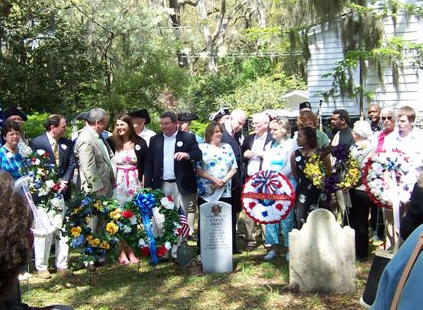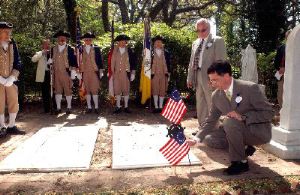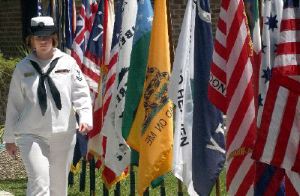Atlanta, Brunswick & Jacksonville News Articles A family saga in black, white Bob Dart - Cox Washington Bureau, Atlanta Journal Constitution, Sunday, May 8, 2005
Marking History
Revolutionary War soldiers, naval victory remembered
By TERRY DICKSON, The Times-Union ST. SIMONS ISLAND -- Historic and Revolutionary War heritage organizations honored heroes and patriots of the war Tuesday by dedicating four memorial markers and unveiling a historic marker to a Georgia Navy victory next door. In a morning ceremony at Christ Church Episcopal, the Sons of the American Revolution and Daughters of the American Revolution honored four island residents who served in the war. Just 2 1/2 hours after that ceremony, the same organizations were joined by the National Park Service and others next door at Fort Frederica National Monument to honor Col. Samuel Elbert's victory over three British warships 227 years earlier. The ceremonies were so close because it is the spot the British established an expensive presence on the barrier island in the 1730s as a buffer to protect South Carolina from invasion from the Spanish in Florida. Christ Church and its cemetery are located just outside the earthen berms that formerly protected the fortified town of Frederica. Historian Buddy Sullivan summed it up in the ceremony at Fort Frederica. "We're walking through history here,'' he said to the crowd of more than 200, some of whom found shade under old live oaks. He encouraged the crowd to put themselves back 300 years and imagine there was nothing there but the oaks and a few Indian tribes. "There were no English settlers at that point. There were deer flies,'' he said.
There were plenty of deer flies and sand gnats at both ceremonies. Sons of the American Revolution color guards in kilts or the blue coats and knee britches of American Revolutionary War soldiers did double duty, leading processions to graves at the 10 a.m. ceremony and to the historic monument at the end of the 2 p.m. dedication. They stood at attention in the morning while brass markers were unveiled at monuments to William Page, Robert Grant, Samuel Wright and Cyrus Dart. Unlike the others, Dart, whose body was never recovered after he drowned nearby, has no grave. Instead, he is remembered at Christ Church in a granite monument provided recently by the Department of Veterans Affairs. Descendants of Elbert and the four soldiers attended the ceremonies in good numbers. Many were local, but some traveled long distances. Descendants read biographies of the patriots including Bill Brown, a great-great-great grandson of Cyrus Dart. Brown noted that Dart was a quarantine officer at the Port of Brunswick and drowned when a rowboat capsized as he and his son Urbanus -- Brown's great-great grandfather -- were rowing to a ship. "I'm glad Urbanus was a good swimmer. Otherwise, I wouldn't be here,'' Brown said as the crowd laughed. Mark Grant and his father, Robert Grant, placed flags on the grave of Robert Grant, who had been a Revolutionary War surgeon on the staff of Francis Marion, the Swamp Fox, in South Carolina.
Mark Grant, from Warrenton, Va., said he learned about "my fourth great-grandfather'' after his own son was born four years ago. "I didn't know anything about my ancestor. I wanted my son to know where he came from,'' Grant said. The ceremony was very meaningful to him and provides a heritage to his children, Grant said. Father and son King Aiken Sr. and King Aiken Jr. are descendants of both Grant and Page because their families intermarried, King Aiken Sr. said. "I'm very proud of what has gone on today,'' King Aiken Sr. said. Aiken said he was gratified by the heavy turnout at the morning ceremony. "Nobody knew what kind of significance anyone would see in it. We too often forget that these people and the ones fighting today make a great sacrifice,'' he said. Of the 73 previous marker dedications, the Christ Church cemetery ceremony was the most heavily attended, said George Thurmond, president of the Georgia Society of the Sons of the American Revolution. Thurmond credited St. Simons Island resident and organizer William Ramsaur for much of the success. "The planning for this has taken a year,'' he said. "He visited at least nine of the 28 state chapters.'' Until Ramsaur began promoting it, the naval action was largely unknown. The historic marker dedication drew James Elbert Whitehead and his family from Cape Canaveral. Whitehead said his family still owns a locket with a miniature portrait of Samuel Elbert, the only known likeness of his forebear. "We looking forward to maybe meeting some of our relatives,'' he said as the marker was unveiled. Virginia Steele Wood gave an account of how Elbert and Georgia soldiers were helped by the tides, winds and good fortune when they used three galleys to outmaneuver the three British sailing vessels. Although it was an obscure battle, it was nonetheless important, Park Superintendent Mike Tennent said. "We lose sight of the fact history is made in small places by ordinary people,'' he said. "For every epic battle, there are a thousand small engagements.'' The people who take part in those actions deserve to be recognized and remembered, he said. Source: Georgia Times Union 4/20/2005, Page 1 http://www.jacksonville.com/tu-online/stories/042005/geo_18524367.shtml
|
 After the
ceremony, when my wife, Sherry, and I had to catch a plane home to Washington,
D.C., McKinley said he and about 11 Darts, all cousins, ''went out to eat and
talk and had a good time.''
After the
ceremony, when my wife, Sherry, and I had to catch a plane home to Washington,
D.C., McKinley said he and about 11 Darts, all cousins, ''went out to eat and
talk and had a good time.'' .jpg) She
presented each "Samuel Wright" she found with a red, white and blue business
card imprinted with the words "Hi Cousin!" and the line of descent from their
common ancestor.
She
presented each "Samuel Wright" she found with a red, white and blue business
card imprinted with the words "Hi Cousin!" and the line of descent from their
common ancestor. 
